Seasons – October 2021
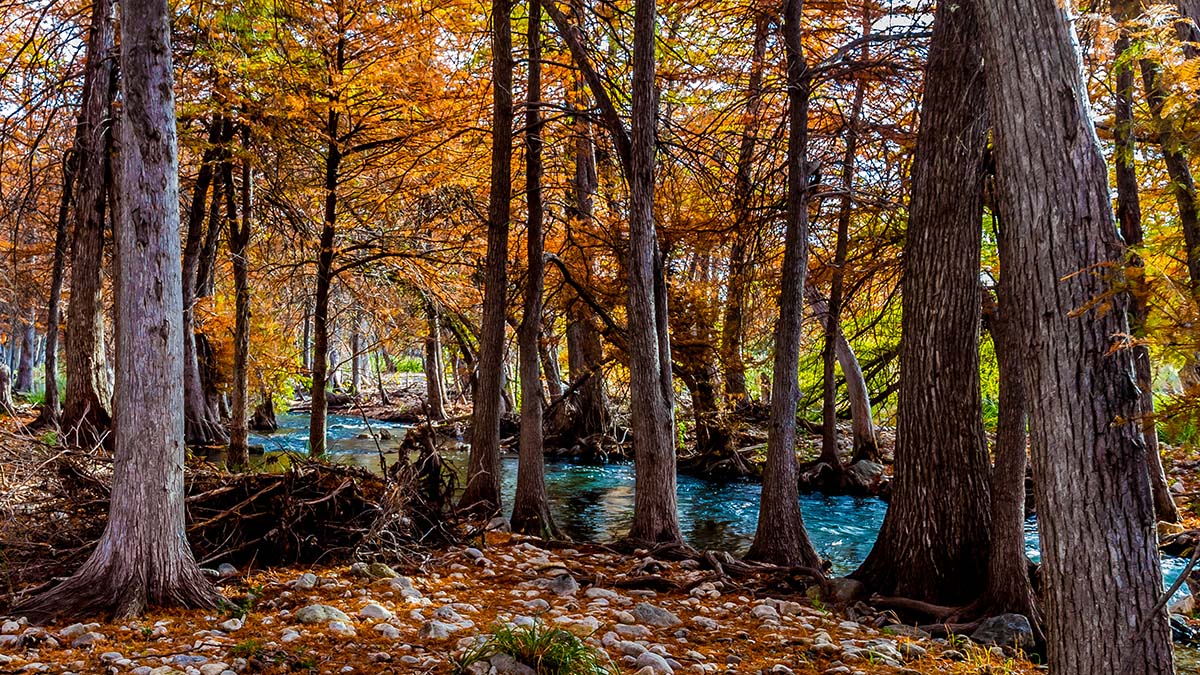
From the Plateau Land & Wildlife Management Team
Another beautiful Texas fall is upon us. It may feel like we are in the middle of summer still, but cooler weather is just around the corner. Have faith it’s coming! And with it, deer and quail season, crisp fall weather, changing leaves, and yes, even the holiday season. It’s an exciting time of the year and a great time to think about your wildlife and wildlife management plans.
Fall brings a rejuvenated excitement for life and an eagerness to reconnect with the land. This spirit is reflected in this issue of Seasons, in which we highlight several opportunities to improve and enjoy your land while also taking care of a few qualifying activities for those in wildlife as their open-space property tax status.
We hope this issue of Seasons will help jump-start your celebration of fall, and if there’s any way that Plateau Wildlife or any of our family members can help you protect, enhance, or better enjoy your land during this special season, just give us a call. We’ll be here when you need us.
Until next Seasons,
The Plateau Team
Table of Contents
Pollinator Webinars: Fall 2021 + On-Demand
Wildlife Management Activity Reminder: Winter Wildlife Surveys
Wildlife Management for Small-Acreage Properties
Service Spotlight: Fall Webinars
How to Read Your Property Tax Bill
Field Notes: Pictures & Highlights of Properties in Wildlife Management
News for Texas Landowners
Pollinator Webinars: Fall 2021 + On-Demand
Join us this October for a free Fall Pollinator Plants webinar!
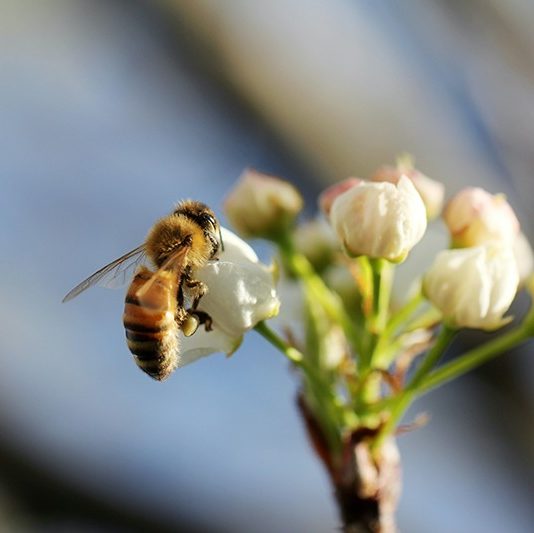 Early Bird Special Webinar – Fall Pollinator Plants: Tuesday, October 5th, 5:45-6:00 PM
Early Bird Special Webinar – Fall Pollinator Plants: Tuesday, October 5th, 5:45-6:00 PM
Join Plateau Wildlife Biologist, James Hall, for a special presentation on fall plants that can encourage native pollinators on your property. This 15-minute “Early Bird Special” preludes a Converting to Wildlife Management webinar in which we take a deeper dive into the Wildlife Management tax valuation law and requirements, the seven activity categories, resources and tips for success, and more! Both presentations are free to attend and will benefit anyone either looking to transition from Ag or Timber to Wildlife Management, or currently in Wildlife Management and need a recap of the activities and requirements.
Listen to our free, on-demand webinar on how to manage for native pollinators!
Rarely do land managers think about the small non-game wildlife that affects their property and even more rarely do they think about the butterflies, wasps, and bees. Texas has a wide array of native and non-native pollinators throughout the state that affects our daily life as we know it. These pollinators are not only a benefit to the ecosystem but are a benefit to the agricultural economy. During this presentation, we will identify some common pollinators seen throughout Texas, discuss the different eco-services that they provide, and outline recommendations for your land to encourage native pollinators, particularly as it applies to the wildlife management valuation.
Presented by James Hall, Senior Wildlife Biologist, Certified Wildlife Biologist, and Registered Property Tax Consultant.
Wildlife Management Activity Reminder: Winter Wildlife Surveys
By Kameron Bain, Landowner Account Manager
 As fall escorts cooler temperatures into our area it also renews an opportunity to become familiar with our wintering and resident wildlife. These visitors won’t be here for long, so put on your jacket and start counting!
As fall escorts cooler temperatures into our area it also renews an opportunity to become familiar with our wintering and resident wildlife. These visitors won’t be here for long, so put on your jacket and start counting!
For informal surveys, simply watch your feeders and water sources and record who is visiting. You can do this by watching in the morning or evening and keeping a log of what you see. You should do this regularly (weekly or monthly) throughout the wintering season or better yet, all-year long. Keep your eyes out for butterflies too, mid-October to mid-November is an excellent time to see migrating butterflies. You can also use remote game cameras that can watch 24/7 and offer an excellent opportunity to record sightings of wildlife, especially shy and elusive species.
Another excellent opportunity is to allow your property to be a part of the regional Christmas Bird Count, which is the longest-running citizen science survey. The National Audubon Society administers the surveys and the data collected is used to monitor population trends of wintering species.
Download the iNaturalist app to help you identify and catalog wildlife and plants seen on your property. See Plateau’s tutorial on iNaturalist
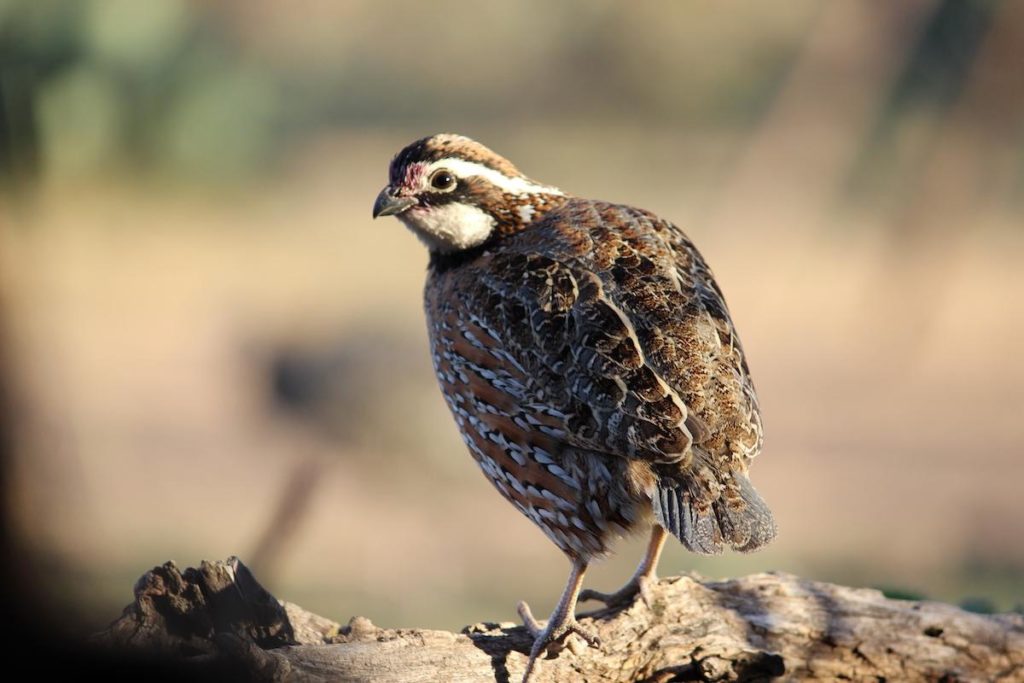 Formal surveys require more experience and knowledge, and may include:
Formal surveys require more experience and knowledge, and may include:
- Time-area counts are structured surveys that involve sitting at representative points throughout your property for a set period of time (typically 10 minutes) and recording all wildlife seen or heard within a set area. These are typically done seasonally, but winter is a great time to start.
- Fall and Winter quail call counts are structured surveys where independent listening stations are set up throughout your property to count individual quail calling in the early morning.
- Winter and resident bird surveys are point-count surveys focused on birds that are seen and/or heard at representative stations throughout your property.
All of these surveys are most informative when conducted annually or often to establish trends in wildlife use of your property. You don’t have to be perfect at your activities, but somebody has to do them. If you need help or have questions please contact us at (512) 894-3479 or [email protected].
Wildlife Management for Small-Acreage Properties
By David Riley, Plateau Staff Biologist II, Associate Wildlife Biologist, & Registered Property Tax Consultant
As seen in the Texas Wildlife Association Magazine, June 2019
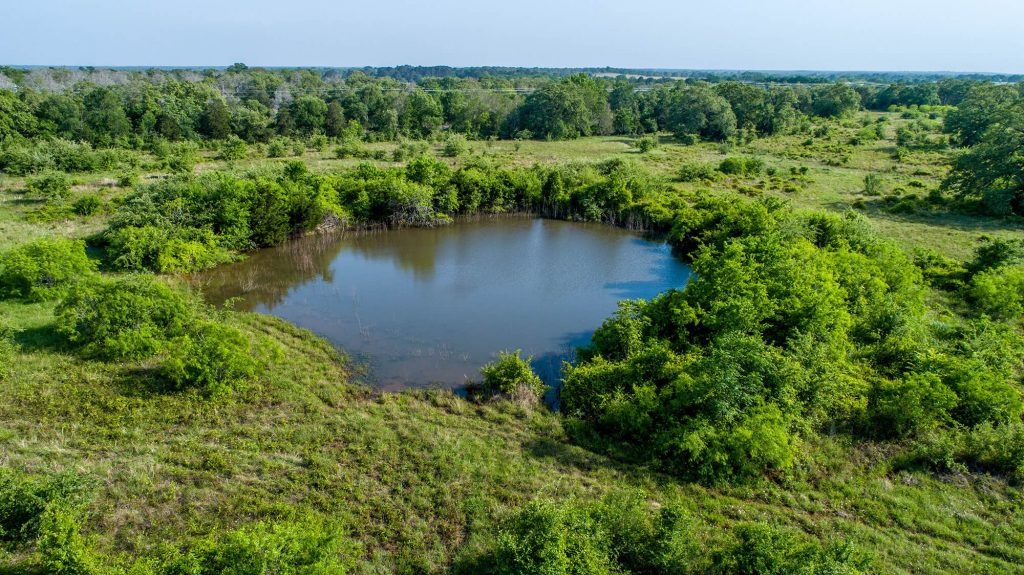 Small-acreage wildlife management is becoming more common every day, especially with the rapidly growing nature of the Texas population, which is expected to reach 45 million by the year 2050. As more and more people move to this great state, the negative impacts of habitat fragmentation become a harrowing reality.
Small-acreage wildlife management is becoming more common every day, especially with the rapidly growing nature of the Texas population, which is expected to reach 45 million by the year 2050. As more and more people move to this great state, the negative impacts of habitat fragmentation become a harrowing reality.
From major housing developments to ranchette-style properties, Texas lands are being steadily carved up, resulting in a loss of contiguous wildlife habitat. Texas property owners can take steps to manage their land, big or small, to counter the effects of habitat fragmentation for the benefit of all wildlife. The cumulative effect of many small-acreage landowners managing for habitat can result in substantial acreages improved for wildlife use.
Land Usage
Historically, large herds of buffalo grazed Texas, roaming freely throughout the state unimpeded by fences or large cities. As westward expansion began, many travelers placed their stake in Texas and started a new life for their families. Livestock became the biggest commodity of the day. Privately owned cattle operations, with their requisite fences and structures, gradually broke up formerly open lands. This was the beginning of fragmentation as we know it.
The establishment of major cities and roads throughout the state has further contributed to land fragmentation. Today, Texas is one of the few states that is primarily privately owned, and many of its private properties are small-acreage ranches or farms.
According to txlandtrends.org, a project of Texas A&M Natural Resources Institute, resident landowner numbers have been on the rise. This indicates that many new landowners are not purchasing rural land exclusively for working or recreational use, but also as their primary residence. High demand leads to high prices and an increase in small-acreage properties that contributes to fragmentation.
Fragmentation can be broken into two different subsets, habitat fragmentation, and ownership fragmentation. Habitat fragmentation can be detrimental to wildlife populations by isolating smaller wildlife populations, reducing access to necessary resources, creating uneven hunting pressures, and contributing to urban-wildlife interface issues.
Ownership fragmentation involves breaking up open space land into smaller tracts, but only on paper. Properly managed, small, contiguous properties can potentially mitigate the detrimental issues that are typically seen with habitat fragmentation. Landowners of small-acreage properties can combine resources and efforts to manage their collective acreage to benefit wildlife and minimize the fragmentation’s results.
Before You Begin
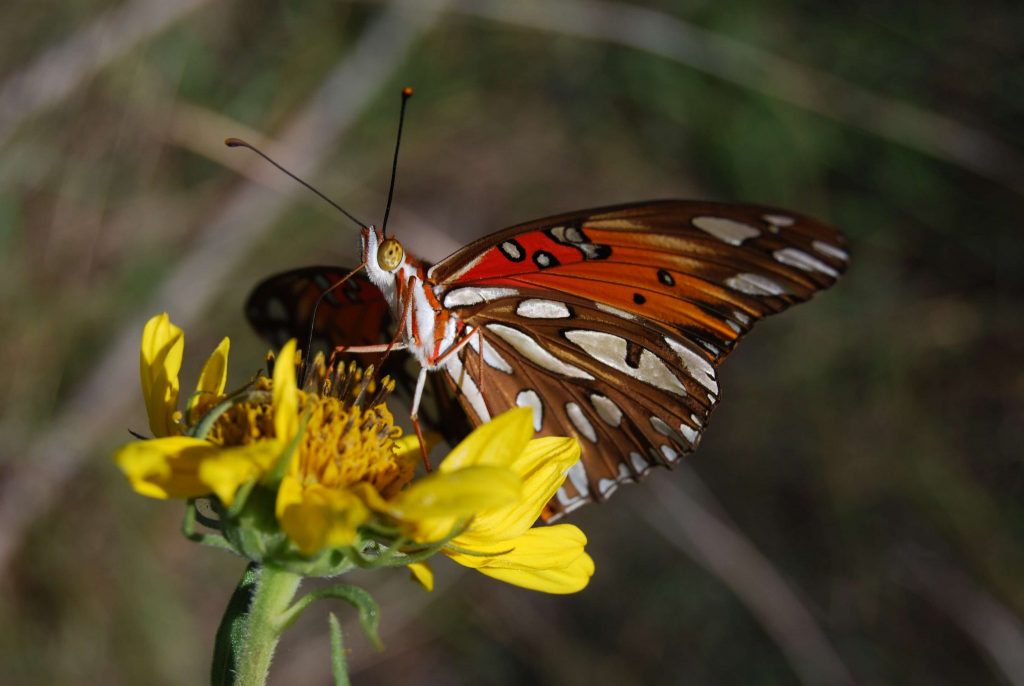 Before you begin managing for wildlife on your small-acreage property, formulating and discussing short and long-term goals with a biologist is ideal. Unnecessary or counterproductive activities can be avoided by simply discussing your vision for the property with a knowledgeable professional, asking questions, and documenting your planned habitat-specific activities in writing.
Before you begin managing for wildlife on your small-acreage property, formulating and discussing short and long-term goals with a biologist is ideal. Unnecessary or counterproductive activities can be avoided by simply discussing your vision for the property with a knowledgeable professional, asking questions, and documenting your planned habitat-specific activities in writing.
For small-acreage properties, it is important to decide on a target species that fits the property. For example, a 20-acre property will have difficulty managing for Northern Bobwhites, which studies have shown need a minimum of 2,500-3,000 acres of contiguous habitat to maintain a stable population. Your efforts, however, can still do good things for quail on your property, as many of the activities that benefit one species can directly or indirectly benefit others.
The most commonly targeted species for management on small properties are songbirds and waterfowl, which are often migratory or require only small habitat-specific areas. Many species of small mammals, reptiles, and amphibians can also be managed in small areas, depending on the specific habitat types your property may have.
Native pollinators, such as native bees, butterflies, and other insects, also make ideal target species for small acreage landowners. Landowners who manage and provide habitat for this special category of wildlife contribute to the improvement and success of ecosystems that have been declining in recent years.
Management Activities
Just as humans have three basic needs for survival–water, food, and shelter–so do wildlife. Promoting access to these three mainstays of life can be easy and important activities for effective wildlife management.
Water
Lack of reliable water sources can be a major limiting factor for wildlife, depending on your location in the state. Placing small, wildlife-friendly water sources on your property is simple and beneficial. Creating entry and escape systems, like a ramp or ladder, is important for keeping these water sources accessible and safe for small wildlife.
For properties with limited access to water sources, a rainwater collection system may be the answer. Systems like these can be built with a variety of materials and are usually self-sustaining, so they can be placed anywhere throughout a property to improve water distribution for wildlife.
Food
Properties targeting songbirds may provide seeds and grains through common hanging feeders or high-capacity free-choice feeders. During the winter season, it is important to provide blackoil sunflower seeds or other seeds with a high-fat content for migratory songbirds. Providing supplemental sources of food through feeders is fun and beneficial, but it is even more important to establish natural food sources throughout the property that can be utilized year-round by a variety of different species.
Activities such as discing, mowing, managed grazing, and prescribed fire can create a more diverse plant community that provides wonderful sources of seeds, fruits, vegetation, and insects for songbirds and other wildlife. Just as discing can be a reliable method for establishing supplemental food plots, it can also be used to set back plant succession, which will, in turn, allow other native plants to establish.
Adjusting the timing and frequency of mowing and discing can produce dramatically different results in plant communities. These activities particularly benefit properties that have an abundance of domesticated grasses like bermudagrass or old world bluestems. Areas that may be degraded or lack a sufficient seedbank may require extra time and effort; however, over time these areas will gradually return to their natural state, providing improved habitat and more reliable food resources for wildlife.
Food plots are often seen as areas in which to plant high-protein plants that can be utilized by white-tailed deer, but that is not their only use. Food plots may also consist of wildflowers or native fruit or seed-bearing plants that are favored by native pollinators and songbirds.
Conducting a combination of these activities will help promote the availability of food supplies for a variety of target species throughout the year.
Shelter
Providing supplemental shelter promotes sufficient availability of nesting and escape cover on small-acreage properties is another crucial activity that will benefit various wildlife species, particularly songbirds. Nesting boxes can be placed throughout a property to provide additional options for cavity nesting songbirds, particularly when standing dead trees (snags) are lacking. The 2011 drought killed many large trees, which, if left standing, make ideal shelter for woodpeckers, owls, mammals, and raptor species.
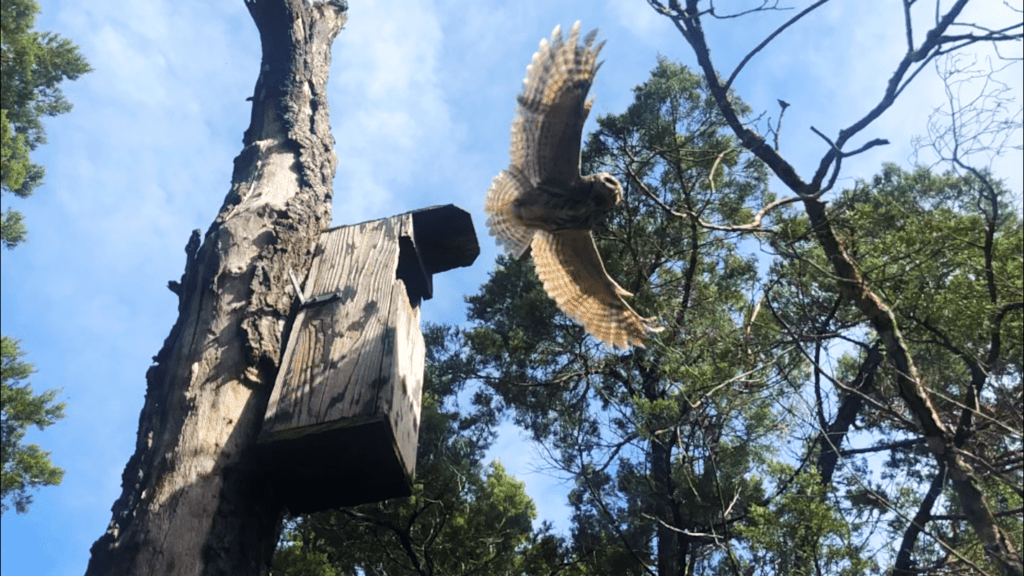
Other Activities
Brush Management: Even in small areas, managing and manipulating brush can have dramatic effects on your property. Commonly, brush management is used to remove or control undesirable or invasive species that typically out-compete native plants or form monocultures (solid, singlespecies stands).
Mechanical techniques for removing undesirable brush are common. A chainsaw and hand loppers are great for maintenance and thinning, while heavy equipment like forestry mulchers or grubbers is more appropriate for larger projects. Creating brush piles from the cut material provides great escape cover for small mammals and nesting areas for native pollinators. These piles should be substantial enough to provide shelter for a variety of species (at least 6′ x 6′ x 6′ in size).
Some plants, such as prickly pear and mesquite, can be hard to control via mechanical methods and require herbicides for effective control. Chemical control of unwanted brush requires training or hiring a knowledgeable professional to make it’s safe, effective, and efficient. Remember that timing matters when you are talking about plants, and an ill-timed herbicide application may be a complete waste.
Strip Mowing: Strip mowing dense grasses at the right time of year can also be beneficial for small wildlife by creating diversity in grass structure, promoting wildflowers and other broadleaf plants, and increasing usable space. Promoting diversity in both habitat structure and composition is important for supporting and sustaining different wildlife species.
Predator Control: Predator control is an often-overlooked activity on small acreage properties but can be very important in the management of quality wildlife habitat. The Brown-headed Cowbird and Red Imported Fire Ant can cause serious damage to your wildlife populations.
Brown-headed Cowbirds are nest parasites that actively seek out nests of native songbirds in which to lay their eggs. Cowbird trapping can be very successful on small-acreage properties, especially if livestock is nearby, and reduce the number of nest parasites found in an area. Texas Parks and Wildlife says that the removal of just one female cowbird can result in the enhanced survival of 35 songbirds annually. Other activities such as shooting and scare tactics can be utilized but may be impractical on a small-acreage property.
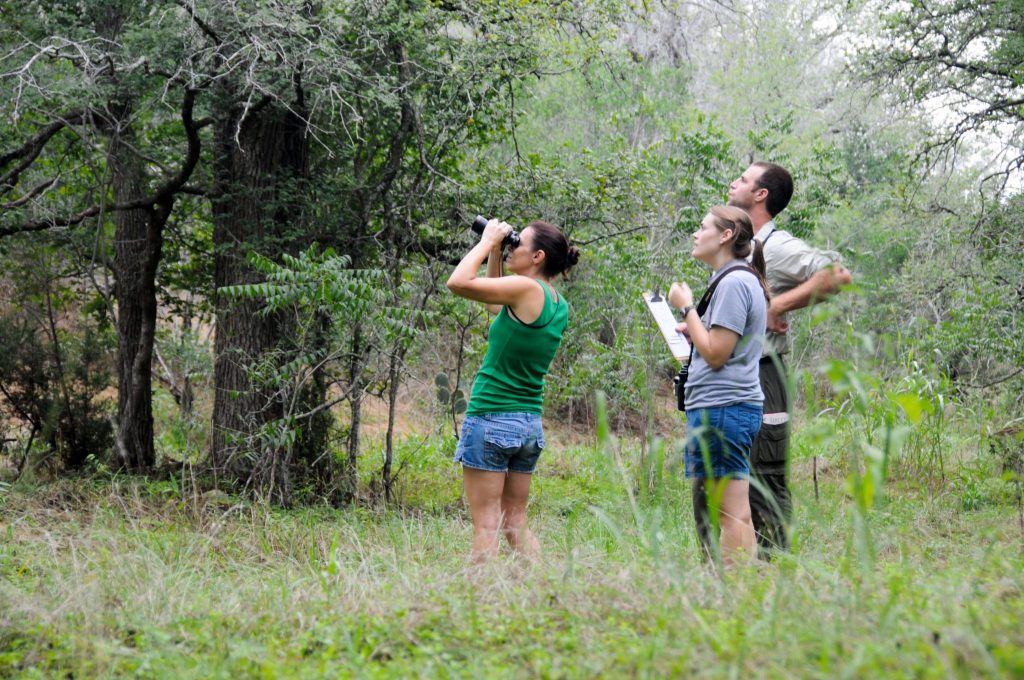
Plateau wildlife biologists perform a Spring Breeding Bird Survey, that counts as a Wildlife Management Activity under the census category.
Red Imported Fire Ants are an invasive species in the U.S. and in the past century have infested 15 states in the south. Spot-treating Red Imported Fire Ant mounds throughout your property is recommended when densities are low. When mound densities are higher, as they often are east of I-35, broadcasting bait may be more effective, though impacts to native ants should be considered.
Census: Finally, any good wildlife management plan should include at least one census activity as a way to monitor wildlife populations on your property and measure the success of your activities. There are a variety of census activities you can conduct. A simple seasonal log of wildlife observed throughout the property can be highly useful. Placing game cameras near water stations or feeders is also helpful for observing wildlife and measuring your success.
Whichever census activity you may choose, it is important to remember to be consistent and stick with it. Changing techniques each year can make it difficult to measure success.
Our Collective Responsibility
As Texas’ population grows at an astonishing rate, many of the open spaces we see today will inevitably be eliminated or encroached upon by growth. There is an evergrowing list of wildlife threatened by habitat loss and changes in land use, including the rusty-patched bumblebee, which was added to the endangered species list in February 2019.
We landowners and conservationists are responsible for the management and protection of the habitats these species require to survive. As the 20th-century American conservationist and environmentalist Aldo Leopold once said, “We abuse land because we regard it as a commodity belonging to us. When we see land as a community to which we belong, we may begin to use it with love and respect.”
Small-acreage properties are becoming more common every day and the dangers of fragmentation are ever-present. Mitigating the issues of fragmentation by applying sound wildlife management principles and being good stewards of the land will safeguard the beauties of Texas and the wildlife we all admire for future generations to experience and appreciate.
If you have questions or would like more information about appropriate Wildlife Management activities for your property, please contact us at (512) 894-3479 or [email protected].
Service Spotlight: Fall Webinars
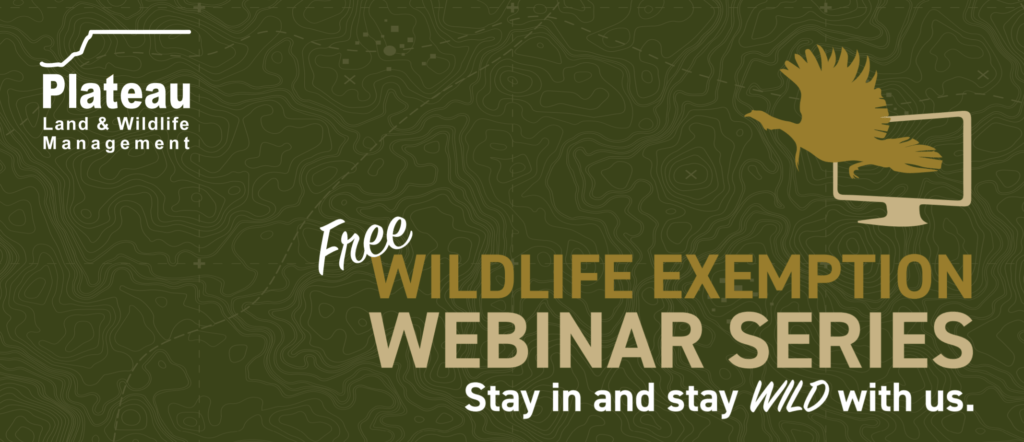
You’re invited to our FREE Wildlife Management webinar series this fall!
Whether you’re already a Plateau customer or someone that wants to learn more about Wildlife Management, everyone is invited to join us for our FREE 2021 Wildlife Management Fall Webinar Series. Connect with experts and other Texas landowners in Wildlife Management and learn all about:
- Wildlife Management Exemption
- Wildlife Management 101
- Qualifying Wildlife Activities
- Property Taxes
- Wildlife Management Plans
- Annual Reports
- County Requirments
- Texas Regional Topics
- Open Questions & Answers
**Plus, join us for an Early Bird Special on select dates and hear from wildlife biologists and Braun & Gresham attorneys about specific issues and topics related to land ownership.**
Topics Include:
- Fall Pollinator Plants
- Birding in the Fall
- Buying Land & Property Tax
- Brush Management in the Fall
- Horses & Wildlife Management
Register Early!
Webinars will be hosted on Tuesdays and Thursdays starting September 21st through November 9th. Visit plateauwildlife.com/webinars to register for the date and topic you choose. Register for as many as you’d like. If you miss one, no problem, just sign up for the next webinar!
Questions? Give us a call at (512) 894-3479 or email [email protected]
How to Read Your Property Tax Bill
By Cassie Gresham, Braun & Gresham Attorney and Counselor

Most landowners can expect to receive their property tax bills in October every year. It is too late to protest your values, but before you pay the bill, I would advise you to check and make sure that it accurately reflects the taxes that you owe.
Here is a Suggested Checklist:
- Does it reflect the correct market value of the property? If you protested your market value, you will want to check to make sure that it reflects the final amount that was agreed to with the appraisal district. If you have an improvement on your land, then you will see three types of market values: (1) Improvement(s) (2) Land around your improvement(s), and (3) Land. If you have an open space valuation on the property, then you won’t pay based on the market value of the land. Instead, you will pay on the “assessed value”.
- Does it show your open space valuation? Check to make sure that your open space valuation (agricultural, wildlife, Ecological Laboratory, or timber) is reflected on your tax bill. This typically is shown under the “productivity” or “ag use” category. This will be a much lower amount than the market value of the land.
- Does your tax bill reflect your exemptions? If you qualify for a homestead, over 65, or disabled veteran exemption, then they should be reflected on your tax bill. The taxing entities will cap the amount that they assess you if you qualify for a reduction due to your homestead or being over 65. You can apply for your homestead any time during the year and it can be retroactive for up to two years prior to the application.
- Did you receive multiple tax bills? While you only apply for exemptions or open space valuations in the county in which your property is located, you might receive multiple tax bills from different counties. This typically occurs in the case where the school district is located in a different county.
- What is your total assessed (taxable) value? This is the total amount that is used to calculate what you will pay in taxes. For example, your total market value might be $500K for your improvements and your land, but due to your exemptions and open space valuation, you may only be assessed taxes on $250K.
- When are your taxes due? Your taxes are due no later than January 31st of every year. If you pay after this date, then your taxes are delinquent. Paying your taxes on time is really important, even if there is a problem with your values or your bill. If you have an outstanding protest with the appraisal district or a lawsuit and fail to pay your taxes on time, then your protest or suit is automatically dismissed.
Your tax bill is the final look at the amount of taxes that you will pay. It is important that you remember to review your Notice of Appraised Value that comes out each year in April. Each year you have the opportunity to protest the loss of any open space valuation, exemptions, or market value of your improvement(s) and land. Your protest is due May 15th of each year, but no later than 30 days after you receive your Notice of Appraised Value.
If you have questions or concerns about your property tax bill, Braun & Gresham can help. The attorneys at Braun & Gresham are not only experts and innovators in ways to utilize property tax incentives and how to reduce your property taxes, but we also serve as your advocates when you are unfairly taxed. We know the rules and how to use them. We also make sure the taxing authorities follow those rules. Please contact us at (512) 894-5426 or email [email protected].
Field Notes: Pictures & Highlights of Properties in Wildlife Management
Ever wonder how Wildlife Management is benefiting landowners’ property and the wildlife that lives on it? Here are some photos and highlights, from Plateau’s field staff and game cameras, of successes and small victories our landowner customers are seeing on their property.
Cactus Wren Nest in Frio County
Check out this Cactus wren nest that was spotted by a Plateau biologist in Frio County. The Cactus wren (Campylorhynchus brunneicapillus) is a specialist to the dry brushland and desert habitats of southwest Texas, where a mixed structure of cactus, yucca, and thorny shrubs can be found. Typically 7-9 inches long, the Cactus wren is the largest wren in North America, characterized by a conspicuous display of barring and speckling. They forage low, preferring to probe for insects beneath leaf litter or in the crevices of rocks and tree bark. A true desert survivor, they derive all their water requirements from their diet. Most intriguing is the boldness they exhibit in predation and territory defense. These clever wrens frequently mob potential predators, brazenly destroy nests of other songbirds, and are known to strategically build “dummy” nests both inbreeding and non-breeding periods. In low western scrublands, listen for the raspy “chur chur chur chur” of the Cactus wren’s song.
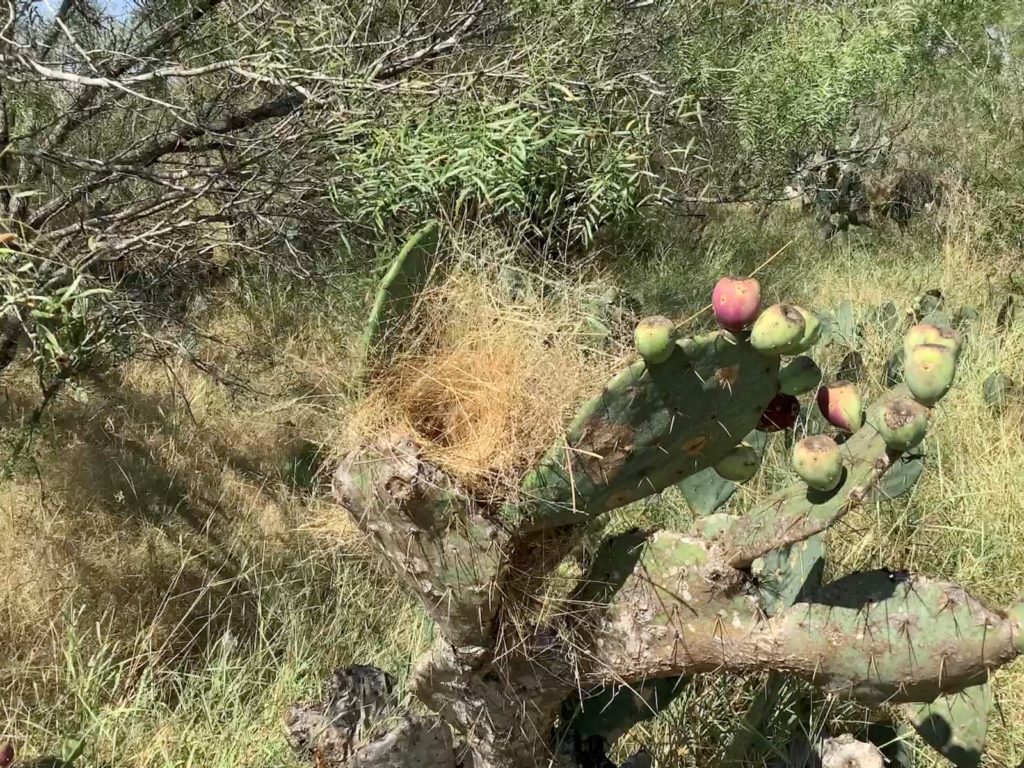
Photo of Cactus wren nest in Frio County, courtesy of Plateau Director of Ecological Services, Shane Kiefer.
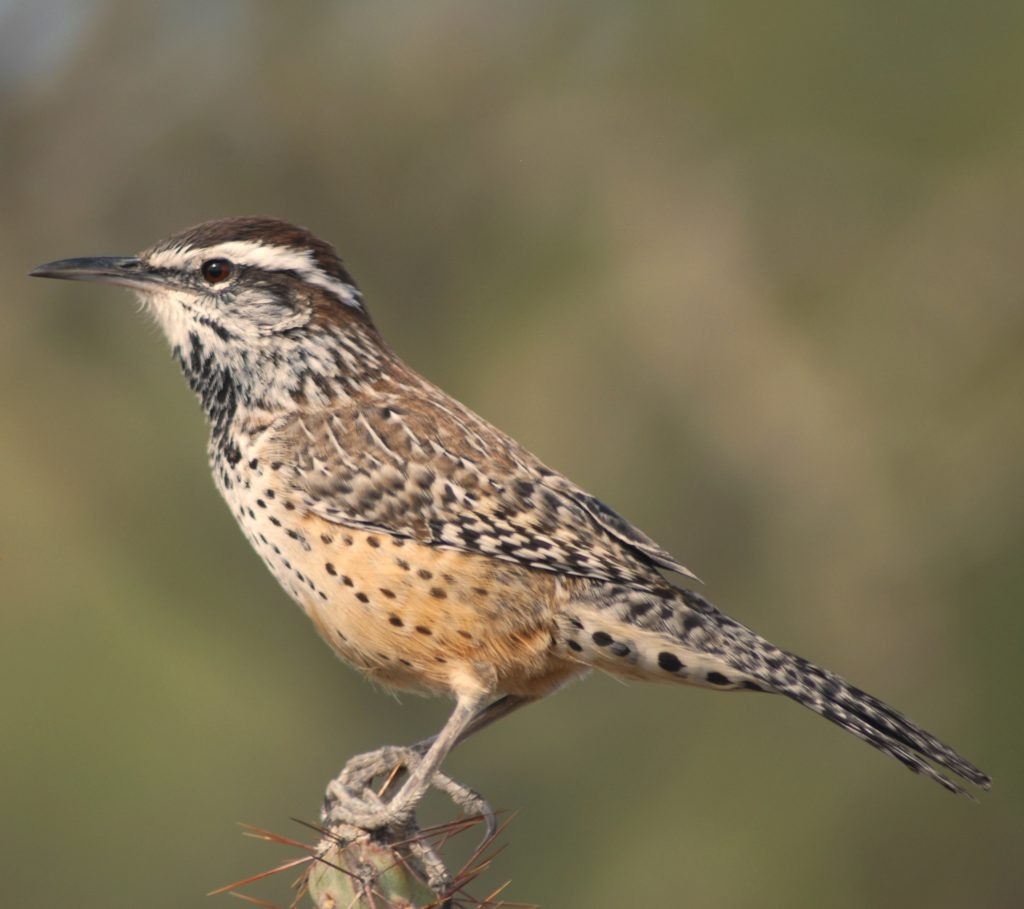
Photo of Cactus wren, courtesy of Plateau Wildlife Biologist, James A. Hall.
Gray Treefrog in Hays County
All kinds of wildlife utilize Plateau’s Water Tables! Pictured below is a Gray Treefrog spotted in Hays County, seeking shelter from the heat of the Texas sun on a Plateau Water Table. Although virtually impossible to distinguish between the Cope’s Gray Treefrog (Hyla chrysoscelis) and Gray Treefrogs (Hyla versicolor), they do produce two distinct calls during the mating season. Gray Treefrogs produce a slow trill call, whereas Cope’s Gray Treefrogs have a fast, high-pitched trill. Both species feature similar morphological characteristics which can be versatile depending on the environment and the season, and can even change their pigment from a light gray to a darker olive green by a process known as metachrosis. Both frogs range extends from the northeastern U.S. to central Texas and is primarily arboreal where they are camouflaged, only coming out of the trees and shrubs to breed from spring to early summer. Not only do the species overlap in distribution and resemble in morphology, but they are also known to interbreed with each other in areas where they co-inhabit.
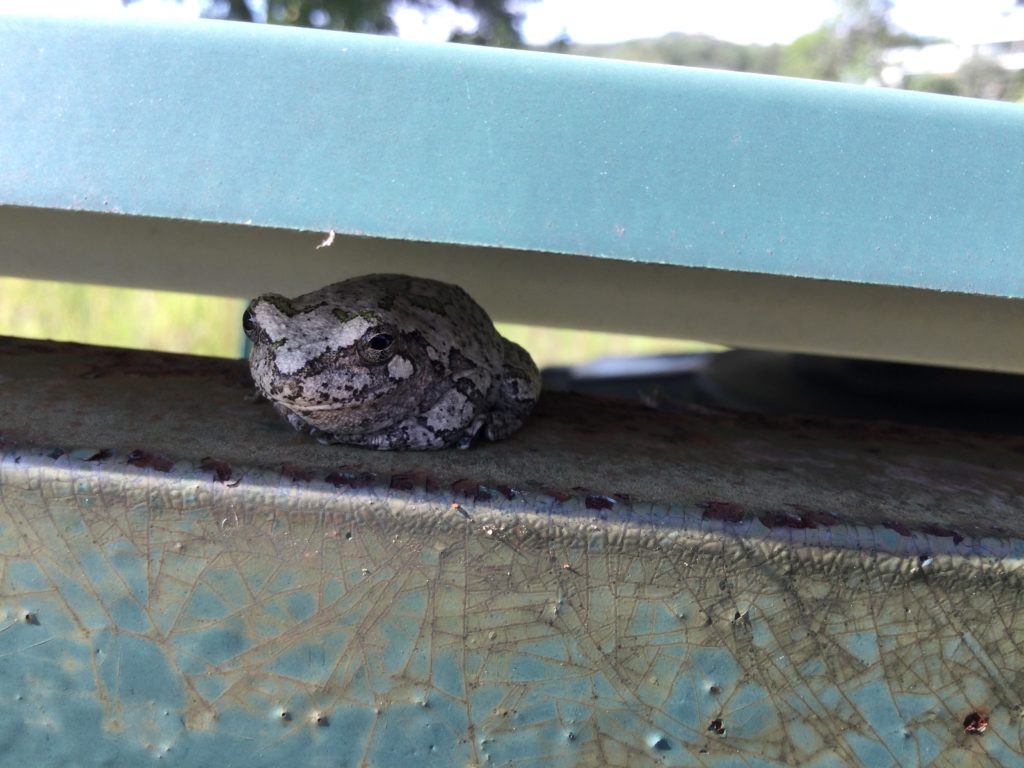
Photo of Gray Treefrog on a Plateau Water Table in Hays County. Courtesy of Plateau Products & Services Technician, Justin Bosler.
So many of you are out there doing great work. We appreciate you, and so do the native wildlife on your property and across Texas. Large or small, you are making a difference. Look for more great examples of wildlife and landowner successes and victories in upcoming Seasons Newsletters!
News for Texas Landowners
Texas’ Chronic Wasting Disease Management Rules Headed for Change
Article by Matt Wyatt for Houston Chronicle
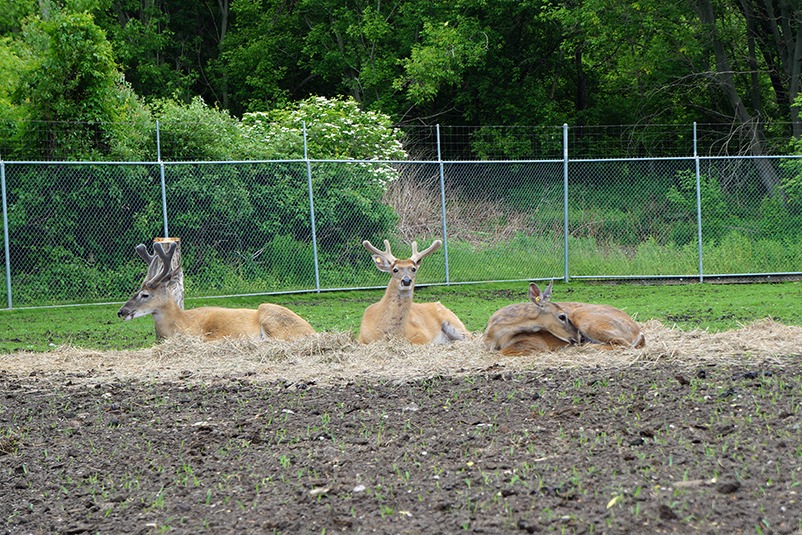
The Texas Parks and Wildlife Commission held a special work session this week, focusing its efforts on chronic wasting disease management. A slate of regulations was proposed that could potentially be adopted at the next commission meeting in early November.
Many of the proposals are geared toward regulation of the deer breeding industry. CWD, an always-deadly neurological disease in cervids, was detected in seven breeding facilities since spring. More than 30 white-tailed deer have tested positive from these facilities, which sparked a massive epidemiological investigation that has encompassed 181 trace breeding facilities and 119 release sites.
Perhaps the most significant of the proposed regulations would be to continue to make mandatory the live testing of deer…
When do I plant wildflower seeds for spring blooms?
Article by Laura Muntean for Texas A&M AgriLife
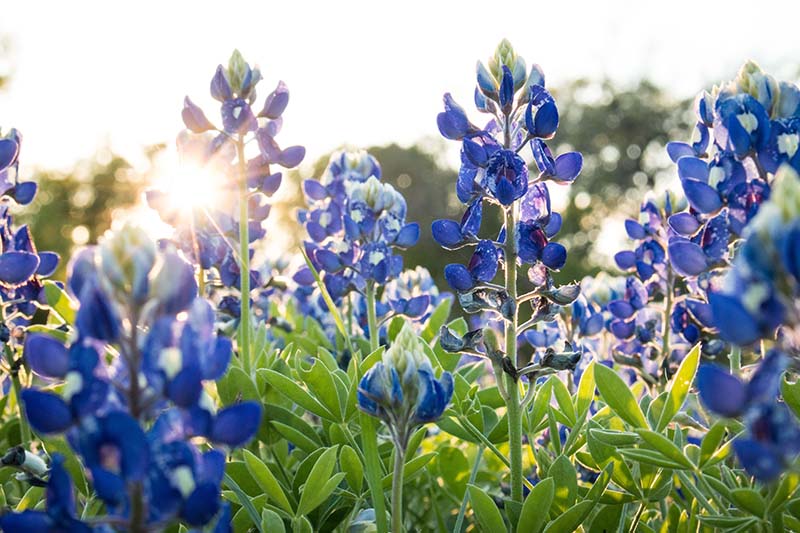
Now is the time for Texas wildflower lovers to plant their favorite varieties for flowers in the spring, said Joseph Johnson, program manager for The Gardens at Texas A&M University.
Planting in the fall — before the start of the rainy season — gives your wildflowers time to germinate and gain a good root system before going dormant during the winter.
“It is good to use a wildflower mix with several different species to ensure year-round interests and not just blooms for the spring,” he said. “This will give you an array of colors, but also an opportunity to see what does especially well in your wildflower area for the next year. If you let your flowers go to seed, you could see them again and again from year to year…”
Hunting Lease Resources
Article by Tiffany Lashmet for Texas Agricultural Law Blog
 With this being the opening weekend of dove season and with deer season coming up soon here in Texas, I’ve gotten a lot of questions and interview requests about hunting leases. We’ve got a variety of resources–many free–that offer great information for landowners interested in allowing others to hunt on their land. I thought it might be useful to write a post just outlining and providing links to those various resources in one place.
With this being the opening weekend of dove season and with deer season coming up soon here in Texas, I’ve gotten a lot of questions and interview requests about hunting leases. We’ve got a variety of resources–many free–that offer great information for landowners interested in allowing others to hunt on their land. I thought it might be useful to write a post just outlining and providing links to those various resources in one place.
With regard to the two handbooks mentioned below, I’ve linked the free PDF versions, but if you would like to order a hard copy, we have those available for sale by calling Lacrecia at 806-677-5600.
First off, landowners should strongly consider having a written hunting lease in place with anyone who will be hunting on the property. This lease does not have to be overly complex or long, but should set forth the understanding of the parties about the rights and responsibilities of the hunter…
Stewarding Rangelands Focus of Oct. 7 Webinar
Article by Susan Himes for Texas A&M AgriLife
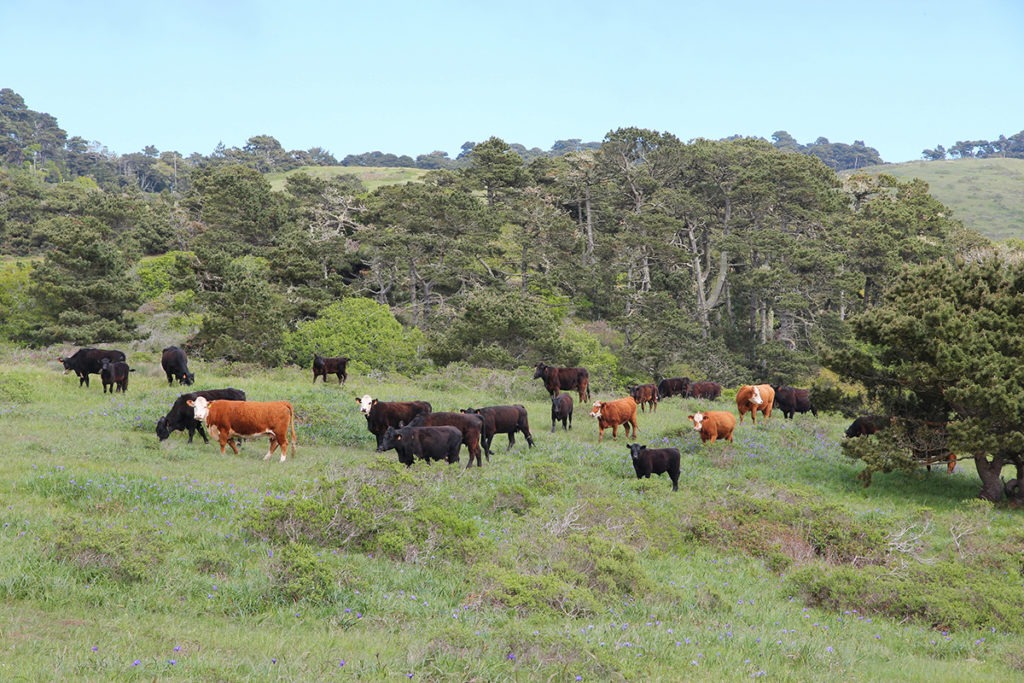 There is a unique relationship between rangeland and grazing livestock, but the human stewardship role can often be overlooked and separated from the science, according to a Texas A&M AgriLife Extension Service expert.
There is a unique relationship between rangeland and grazing livestock, but the human stewardship role can often be overlooked and separated from the science, according to a Texas A&M AgriLife Extension Service expert.
AgriLife Extension will present a webinar addressing stewardship issues on Oct. 7. “Stewarding Rangelands,” part of the ongoing Rangeland, Wildlife and Fisheries Management Stewardship Series of webinars, will be presented from noon to 1 p.m. online.
The cost is $35. Advance registration at https://tx.ag/RWFMSeriesOct is required for all participants. Upon completion of registration and payment, participants will receive an email with two attachments — a receipt and a registration confirmation…
Read more
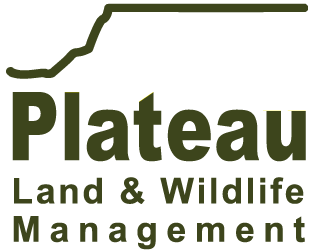





Sorry, the comment form is closed at this time.